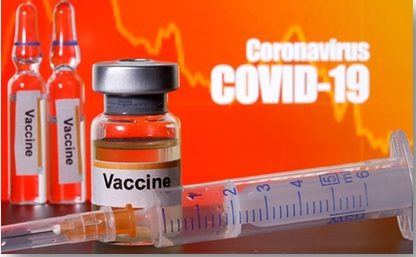

|
Syllabus: Prelims GS Paper I : Current Events of National and International Importance. Mains GS Paper III : Awareness in the fields of IT, Space, Computers, Robotics, Nano-technology, Bio-technology and issues relating to Intellectual Property Rights. |
Context: Detailed planning of phased distribution of Corona vaccine to the general public.
 Background: Ensuring that the vaccine against the coronavirus disease reaches everyone in the country dominated the discussion in the recently held meetings at higher official level. At the meeting, Union health secretary told to the states that the Centre was looking at providing vaccination to front line health workers in the first stage, police personnel and sanitation workers in the second stage, those above 50 years of age in the third, and those with comorbidity in the fourth stage. He asked states to provide database of people in these four categories to create a vaccination road map.
Background: Ensuring that the vaccine against the coronavirus disease reaches everyone in the country dominated the discussion in the recently held meetings at higher official level. At the meeting, Union health secretary told to the states that the Centre was looking at providing vaccination to front line health workers in the first stage, police personnel and sanitation workers in the second stage, those above 50 years of age in the third, and those with comorbidity in the fourth stage. He asked states to provide database of people in these four categories to create a vaccination road map.
Distribution Strategy
The coronavirus (COVID-19) vaccine, once available, will be distributed under a special COVID-19 immunisation programme with the Centre procuring the doses directly and making it available for priority groups.
According to them, the Centre will procure the vaccine directly to make it available to the priority groups free-of-charge through the existing network of States and districts. States have been asked not to chart separate pathways of procurement.
The Centre, with the help of State and Union Territory governments, has started the process of identifying around 30 crore priority beneficiaries who would be given vaccine dose in the initial phase.
This special COVID-19 immunisation programme would run in parallel with the Universal Immunisation Programme, but will use its processes, technology and network of the existing vaccine distribution framework.
The government has demarcated four categories of people for vaccination in the initial phase, around one crore healthcare professionals including doctors, MBBS students, nurses and ASHA workers, etc.
Around two crore frontline workers including municipal corporation workers, personnel of the police and armed forces, about 26 crore people aged above 50, and a special group of those below 50 years of age with co-morbidities and requiring specialised care.
Phased Process
The primary objective is to ensure access of vaccine for every indian who wants it, once the vaccine has received approval or authorization from the Drug Controller General, the four key tasks to achieve:
Vaccine Developers and India
Three COVID-19 vaccines have claims of about 90-95% protective efficacy, including BNT162b2 (Pfizer-BioNTech), mRNA-1273 (Moderna) and Sputnik-V (Gamaleya Institute).
Hopefully they will soon get registration for general use in their respective countries of origin. Sputnik-V is under phase 2-phase 3 vaccine trials in India, by an Indian laboratories.
Another vaccine, ChAdOx1 nCoV-19 (Oxford-AstraZeneca), manufactured under licence by Serum Institute of India as Covishield, is undergoing phase 2-phase 3 trials in India.
The likelihood of Sputnik-V getting registration in India is probably high, possibly before end-2020. An indigenous vaccine candidate, Covaxin (Bharat Biotech), found safe and immunogenic in phase 1 and phase 2 trials, is now under phase 3 trial. If found safe and effective, it will, hopefully, get registration in the first or second quarter of 2021.
Vaccination Policy
In the seventh schedule, Public health is in State list, in entry 6, However, under the national Universal Immunisation Programme (UIP), policy, vaccines procured and supplied by the Union government and vaccination implemented by State governments.
So, policy development is the function of the central government. States must implement the action plan emerging from policy. States have the freedom to surpass policy limits if no fund is sought.
There are precedents: Delhi used the Measles-Mumps-Rubella vaccine when the central government policy was only for Measles vaccine and Sikkim unilaterally used human papillomavirus vaccine to prevent cervical cancer in women.
Conclusion
The vaccination stations should be staffed with trained personnel and supervised by medical doctors. The site must have a waiting area and a post-vaccination staying area to manage any untoward reaction during the first hour.
A computerized master list with details and mobile numbers of all vaccinated subjects needs to be maintained for the purpose of post-vaccination follow up to document rare side-effects. Data management has to be meticulously planned and executed.
Connecting the Article
Question for Prelims : In relation to the Drugs Controller General of India, consider the following statements:
1. It is responsible for approval of licenses of specified categories of drugs.
2. It acts as appellate authority in case of any dispute regarding quality of drugs.
Which of the statements given above is/are correct ?
(a) 1 only
(b) 2 only
(c) Both 1 and 2
(d) Neither 1 nor 2
Question for Mains : "The biggest benefit that India has is that it has a robust immunisation programme in place and it is implementing the largest immunisation programme of the world, with nearly 27 million newborns targeted for immunisation annually". In the light of the above statement, Discuss the health infrastructure for robust delivery of medical facility in India.

Our support team will be happy to assist you!
